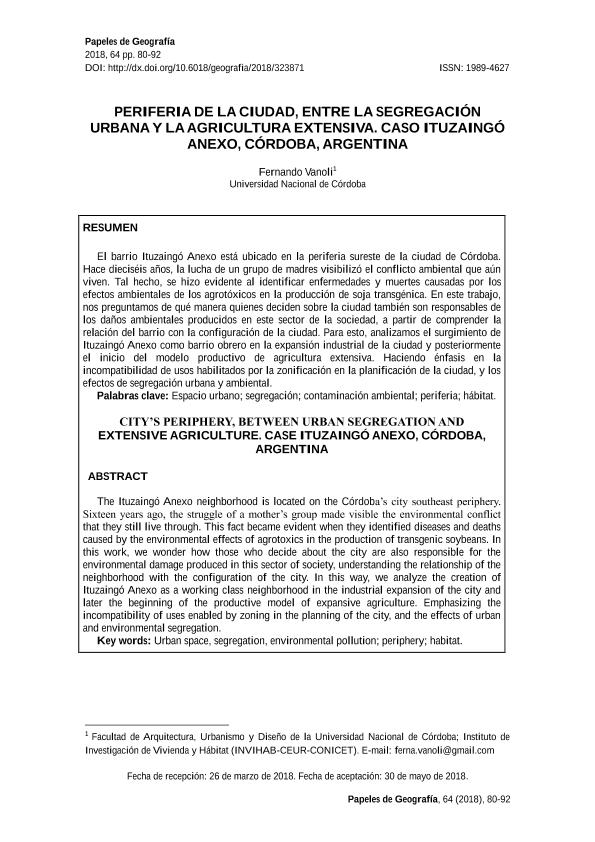Mostrar el registro sencillo del ítem
dc.contributor.author
Vanoli, Fernando Nicolas

dc.date.available
2023-01-04T19:26:56Z
dc.date.issued
2018-05
dc.identifier.citation
Vanoli, Fernando Nicolas; Periferia de la ciudad, entre la segregación urbana y la agricultura extensiva: caso Ituzaingó anexo, Córdoba, Argentina; Universidad de Murcia; Papeles de Geografía; 64; 5-2018; 80-92
dc.identifier.uri
http://hdl.handle.net/11336/183409
dc.description.abstract
El barrio Ituzaingó Anexo está ubicado en la periferia sureste de la ciudad de Córdoba. Hace dieciséis años, la lucha de un grupo de madres visibilizó el conflicto ambiental que aún viven. Tal hecho,se hizo evidente al identificar enfermedades y muertes causadas por los efectos ambientales de los agrotóxicos en la producción de soja transgénica. En este trabajo, nos preguntamos de qué manera quienes deciden sobre la ciudad también son responsables de los daños ambientales producidos en este sector de la sociedad, a partir de comprender la relación del barrio con la configuración de la ciudad. Para esto, analizamos el surgimiento de Ituzaingó Anexo como barrio obrero en la expansión industrial de la ciudad y posteriormente el inicio del modelo productivo de agricultura intensiva. Haciendo énfasis en la incompatibilidad de usos habilitados por la zonificación en la planificación de la ciudad, y los efectos de segregación urbana y ambiental.
dc.description.abstract
The Ituzaingó Anexo neighborhood is located on the Córdoba’s city southeast periphery. Sixteen years ago, the struggle of a mother’s group made visible the environmental conflict that they still live through. This fact became evident when they identified diseases and deaths caused by the environmental effects ofagrotoxics in the production of transgenic soybeans. In this work, we wonder how those who decide about the city are also responsible for the environmental damage produced in this sector of society, understanding the relationship of the neighborhood with the configuration of the city. In this way, we analyze the creation of Ituzaingó Anexo as a working class neighborhood in the industrial expansion of the city and later the beginning of the productive model of expansive agriculture. Emphasizing the incompatibility of uses enabled by zoning in the planning of the city, and the effects of urban and environmental segregation.
dc.format
application/pdf
dc.language.iso
spa
dc.publisher
Universidad de Murcia

dc.rights
info:eu-repo/semantics/openAccess
dc.rights.uri
https://creativecommons.org/licenses/by-nc/2.5/ar/
dc.subject
ESPACIO URBANO
dc.subject
SEGREGACIÓN
dc.subject
CONTAMINACIÓN AMBIENTAL
dc.subject
PERIFERIA
dc.subject.classification
Estudios Urbanos

dc.subject.classification
Geografía Económica y Social

dc.subject.classification
CIENCIAS SOCIALES

dc.title
Periferia de la ciudad, entre la segregación urbana y la agricultura extensiva: caso Ituzaingó anexo, Córdoba, Argentina
dc.title
City’s periphery, between urban segregation and extensive agriculture: case Ituzaingó anexo, Córdoba, Argentina
dc.type
info:eu-repo/semantics/article
dc.type
info:ar-repo/semantics/artículo
dc.type
info:eu-repo/semantics/publishedVersion
dc.date.updated
2023-01-03T14:37:07Z
dc.identifier.eissn
1989-4627
dc.journal.number
64
dc.journal.pagination
80-92
dc.journal.pais
España

dc.journal.ciudad
Murcia
dc.description.fil
Fil: Vanoli, Fernando Nicolas. Consejo Nacional de Investigaciones Cientificas y Tecnicas. Oficina de Coordinacion Administrativa Saavedra 15. Centro de Estudios Urbanos y Regionales. Grupo Vinculado Instituto de Investigacion de Vivienda y Habitat Al Ceur.; Argentina
dc.journal.title
Papeles de Geografía
dc.relation.alternativeid
info:eu-repo/semantics/altIdentifier/url/https://revistas.um.es/geografia/article/view/323871
dc.relation.alternativeid
info:eu-repo/semantics/altIdentifier/doi/http://dx.doi.org/10.6018/geografia/2018/323871
Archivos asociados
